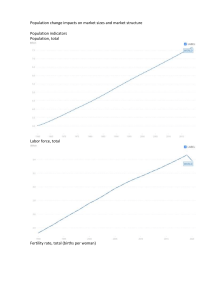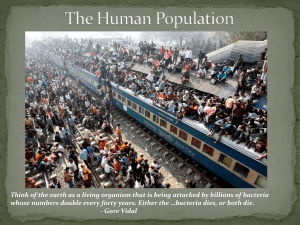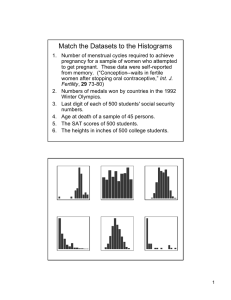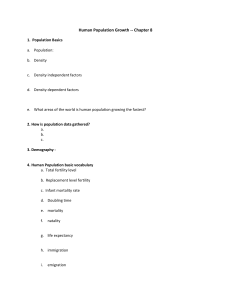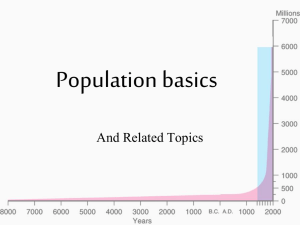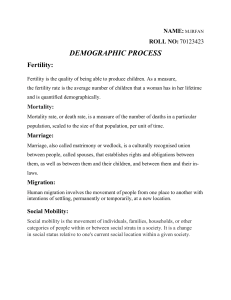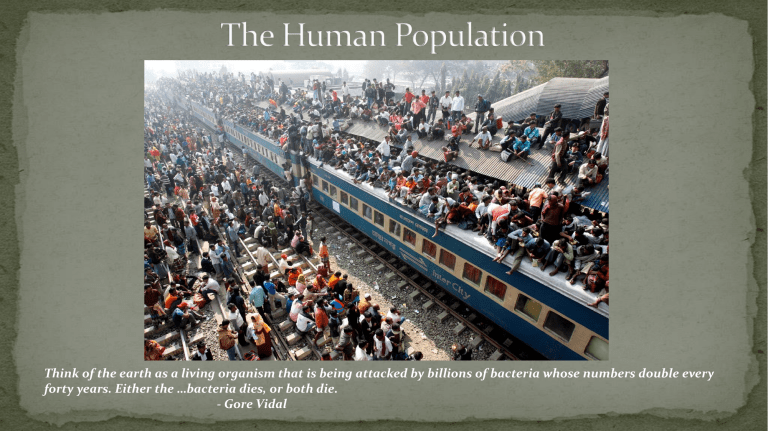
Think of the earth as a living organism that is being attacked by billions of bacteria whose numbers double every forty years. Either the …bacteria dies, or both die. - Gore Vidal During the earliest parts of human history, our population survived as hunter-gatherers. Population during this time was low due to density-dependent growth limiting factors: Competition for food Availability of water Predators Disease The indigeonous Hadza people of Tanzania. 2 At some point, estimated to be about 130,000 years ago, Homo sapiens migrated out of Africa into the Fertile Crescent. 3 The Fertile Crescent was an especially biodiverse area, due to several factors: The area was a geographic “bridge” between two other continents. Proximity to the Mediterranean sea reduced the impacts of climate change as the glacial period ended. Variety of elevation created many microclimates. It included floodplain areas, which receive nutrients from the river. 4 The Fertile Crescent is seen as the birthplace of agriculture, the growing of plants and animals for food, fiber, and other products. Plowing was used to loosen up the soil. Artificial selection was used to breed native animals and plants with desired traits into crops we still use today: Wheat, barley, flax, chick peas, peas, lentils. Cows, goats, sheep, and pigs. 5 Agriculture helped reduce the impact of food availability and competition as a densitydependent growth limiting factor, and the human population began to increase. Other factors, such as disease, were still present. 6 The Industrial Revolution was a transition from hand production methods to machines, including the increased use of steam power and factories. During this time, many important medical discoveries were made: The Germ Theory, the idea that microscopic bacteria and viruses cause disease. Vaccines, injections of dead or weakened viruses that prevent disease. Antibiotics, chemical compounds that kill bacteria. Water treatment, the filtration and addition of chlorine to water to remove microorganisms and toxins. 7 Prior to the industrial revolution, human population growth was fixed, meaning it grew at a consistent rate. About 0.1% per year. 8 Following the industrial revolution, human population growth was exponential, an increasingly rapid rate with a continuously growing base and a low doubling time. 9 Doubling time is an estimate of how long it will take the population to double in size at its current rate of growth. Doubling time is calculated with this equation: 70 / (Current % Growth Rate) Year Growth Rate Doubling Time 1543 1737 1803 0.10% 0.12% 0.28% 700 years 1928 1975 0.56% 0.92% 125 years 1987 1.89% 583 years 250 years 76 years 37 years 11 Demographics is the statistical study of human population data. Demographics and growth patterns may vary widely between different countries. Developing countries have populations that tend to be poorer, younger, and are growing much more rapidly. Developed countries are wealthier, older, and have populations that are stable in size or shrinking. 12 Life expectancy measures how long an average newborn will live in a given country. 13 Life expectancy is influenced by the rate of diseases, availability of food and water, conflict, but most of all by infant mortality. Infant mortality is the number of deaths of infants under one year of age per 1,000 live births. 14 The total fertility rate, the average number of children a woman will have in her lifetime. A total fertility rate of 2.1 is considered replacement level and will result in a stable population. 15 Gross domestic product (GDP) is the total value of goods produced and services provided in a country during one year. GDP per capita divides the GDP by the total population. 16 The Genuine Progress Indicator is a metric designed to incorporate factors ignored by GDP. Income inequality Costs of environmental degradation Social factors, such as education, leisure time, family dynamics 17 The use of GPI reveals social and environmental issues hidden by GDP. 18 The movement of individuals between areas can have a major impact on population change. Emigration is when people move out of an area. More likely to occur in developing countries. Immigration is when people move into an area. More likely to occur in developed Ellis Island countries. 19 For a developed country, immigration can mean the difference between low, positive growth rates, and negative growth. 20 Population pyramids graphically show the distribution of defined age groups, separated by gender. 21 Countries in rapid growth will be pyramid-shaped, with a wide base of young people. Countries in slow growth have age groups that are roughly equal. Countries in negative growth have narrower bases, indicating a fertility rate below replacement level. 22 The fertility rate and population growth patterns in a given country will not remain constant. They change based on a wide variety of factors. United States Fertility Rates, 1911-2011 23 The demographic transition model is a series of stages countries generally pass through as they industrialize and transition from developing to developed countries. Each stage is marked by changes in birth rate, death rate, living conditions, and cultural norms. 24 During the pre-industrial stage, food shortages, malnutrition, poor sanitation, and lack of access to modern medicine keep death rates high. High birth rates counteract this, resulting in stable population sizes. No present-day country is in the pre-industrial age. 25 Preindustrial cultures had significant pronatalist pressures to ensure high birth rates. Pronatalist pressures are policies or cultural beliefs aimed at increasing the birth rate or maintaining a high birth rate, which was needed for: A source of support for elderly parents. Aid in supporting family income. Counteracting high child mortality rates. The son preference: a desire to have a male child. 26 During the early transition stage, access to food and medicine improve, leading to a rapid drop in death rates. Birth rates remain high, as pronatalist cultural norms and pressures remain in place. Populations in early transition countries grow exponentially. 27 During the late transition stage, death rates remain low, and efforts are made to reduce birth rate. Birth control and sex education gain greater acceptance. Women play a greater role in family planning. Educational and professional opportunities for women increase. The population continues to increase, but at slower and slower rates. 28 The industrial stage marks the point where birth rates have fallen back into balance with death rates. Total fertility rate is close to replacement level (2.1 children per couple), causing the population to stabilize. 29 During the post-industrial stage, birth rates continue to fall due to antinatalist pressures Total fertility rate is below replacement level. The population size decreases. 30 The length of time a country spends in the early and late transition stages determine how large its population will be when it is fully industrialized. 31 Some countries have instituted antinatalist programs and laws to rapidly reduce birth rates and accelerate the demographic transition. China implemented a one child policy in 1979 that was altered to a two-child policy in 2015. 32 Antinatalist efforts, combined with a son preference, have left some countries with a disproportionate number of boys compared to girls. 33 Most demographers believe the world population will stabilize sometime during the next century. Population projections vary depending on how quickly developing countries pass through the demographic transition.
